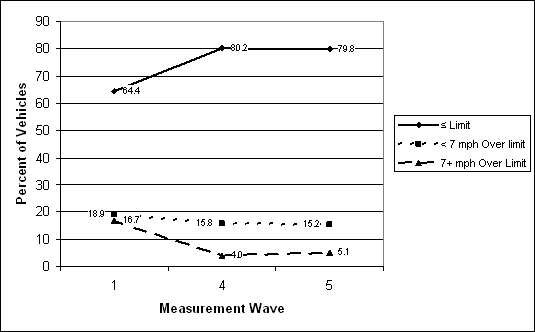5. PROGRAM EVALUATION (continued)
5.3.3.5 Phoenix – ClarendonClarendon is a through street with a 25 mph speed limit that has had speed humps for some time. The test was conducted there not only to see what would happen to speeds overall but also to determine if a change could be induced on the sections between the humps. As stated earlier, residents were complaining that the existing vertical treatments were spaced too far apart thereby prompting motorists to speed between the humps.
There is no neighborhood association for Clarendon, and much of the population is Spanish-speaking. As a result, the education campaign likely had moderate intensity even though many of the materials were translated into Spanish. Police enforcement was applied at a level the police administrators considered commensurate with the low baseline mean speeds.
The data collection procedure on Clarendon had counters installed coincident with each of the three existing speed humps as well as two additional counters between them (see Appendix E). Three waves of measurements were taken (Waves 1, 4, and 5). The mean speed at the three existing speed humps actually went up slightly across the waves from 11.164 mph (Wave 1) to 11.515 mph (Wave 4) and 12.005 mph (Wave 5). These speeds are still half of the prevailing speed limit. Thus, there was no correctable issue with the speeds at the humps, and therefore no detailed results are presented for the measurements taken directly at the speed humps.
The speeds at the two locations between the humps, however, showed a significant drop as indicated in Table 64 and Figure 12. These data for measurements taken at the two sensors between the speed humps show a distinct drop in speeds that is sustained through both post waves. The reduction in drivers going 7+ mph over the prevailing 25 mph limit is particularly noteworthy. The pattern in Table 64 suggests that the original complaints of the residents may have been caused either by the large differential in average speed between the humps and the inter-hump areas or as a result of the surprisingly large percentage of drivers (16.7%) going 7+ mph above the limit between the speed humps during the baseline (Wave 1).
Table 64. Phoenix – Clarendon Speed Results
(Only Sensors Between the Existing Speed Humps)
Wave |
Measure |
|||||||
|---|---|---|---|---|---|---|---|---|
Mean Speed (mph) |
Mean Difference From Wave 1 (mph) |
Mean Above Limit (mph) |
Mean of Speeders (mph) |
N and % At or Under Limit |
N and % < 7 mph Over |
N and % 7+ mph Over |
Total N |
|
1 |
23.069 |
|
-.431 |
3.099 |
2804 |
825 |
727 |
4,356 |
2 |
|
|
|
|
|
|
|
|
3 |
|
|
|
|
|
|
|
|
4* |
20.563 |
-2.506 (.000) |
-2.937 |
1.235 |
3395 |
670 |
170 |
4,235 |
5* |
20.556 |
-2.513 (.000) |
-2.944 |
1.333 |
3256 |
619 |
207 |
4,082 |
| *After the application of education and enforcement | ||||||||
The number of vehicles measured on Clarendon between the humps stayed relatively constant across the measurement waves. This suggests that there was no meaningful diversion of traffic from the road as a result of the education and enforcement efforts.
Figure 12. Speed Classes on Phoenix – Clarendon Between the Speed Humps
